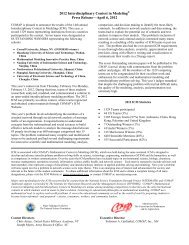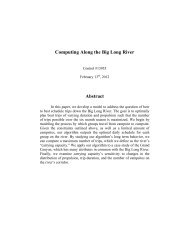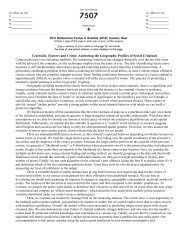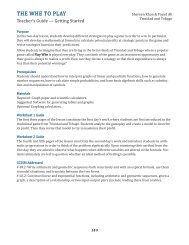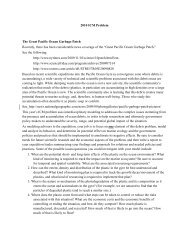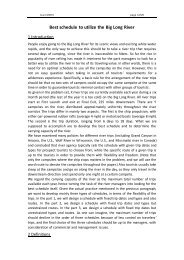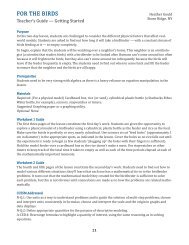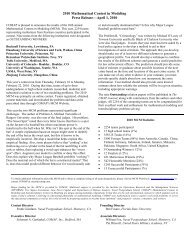Team 9159: Higher in the Air: Design of Snowboard Course
Team 9159: Higher in the Air: Design of Snowboard Course
Team 9159: Higher in the Air: Design of Snowboard Course
Create successful ePaper yourself
Turn your PDF publications into a flip-book with our unique Google optimized e-Paper software.
<strong>Team</strong> # <strong>9159</strong> page17 <strong>of</strong> 22<br />
We use (x ′ , y ′ ) to describe <strong>the</strong> new course. It is <strong>the</strong> upper part <strong>of</strong> <strong>the</strong> curve<br />
edge trapezoid formed by a plane and <strong>the</strong> halfpipe. Under <strong>the</strong> coord<strong>in</strong>ates transformation<br />
<strong>in</strong> Eq. (5), <strong>the</strong> problem changes to a 2-D case.<br />
⎧<br />
⎨<br />
⎩<br />
√<br />
x ′ = 1 + l2 x,<br />
W 2<br />
y ′ = y − x l s<strong>in</strong> ϕ.<br />
W<br />
By adopt<strong>in</strong>g Eq. (11), we can work out <strong>the</strong> correspond<strong>in</strong>g a ∗ and b ∗ similarly.<br />
a ∗ and b ∗ are calculated numerically accord<strong>in</strong>g to different slope angle ϕ, and <strong>the</strong><br />
result is <strong>in</strong> Fig. 17.<br />
Fig 17: Left: E t -a curve under different b; Right: E t -b curve under different a. The<br />
snow friction and collision are considered<br />
The conclusion we make <strong>in</strong> 2D case holds for <strong>the</strong> 3D case here. b ∗ reaches h 0<br />
and a ∗ lies <strong>in</strong> [x 0 , w].<br />
Now we beg<strong>in</strong> to analyze <strong>the</strong> <strong>in</strong>fluence brought by slope angle ϕ. With o<strong>the</strong>r<br />
parameters fixed, we calculate <strong>the</strong> a ∗ and b ∗ accord<strong>in</strong>g to ϕ, respectively.<br />
It turns out that a steeper slope requires smaller a ∗ , which is shown <strong>in</strong> Fig. 18.<br />
Meanwhile, b ∗ is always equal to h 0 regardless <strong>of</strong> ϕ. The sensitivity coefficient <strong>of</strong><br />
a ∗ accord<strong>in</strong>g to ϕ is -0.4605 at ϕ = 17.0 o<br />
Now it’s time for us to determ<strong>in</strong>e <strong>the</strong> suitable ϕ for a halfpipe. The calculation<br />
above only concerns half <strong>of</strong> <strong>the</strong> course, that is from <strong>the</strong> hang<strong>in</strong>g to <strong>the</strong> nadir <strong>of</strong><br />
<strong>the</strong> curve. Here we complete <strong>the</strong> whole curve for one trick to work out <strong>the</strong> best ϕ,<br />
denoted as ϕ ∗ .<br />
17







